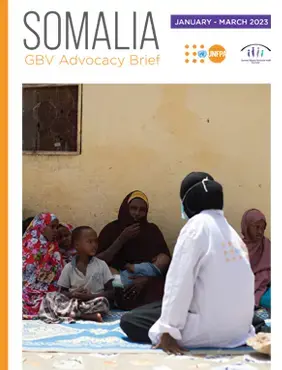The drought crisis in Somalia, which is now in its sixth season without rain, continues to be one of the most severe and felt shocks, endangering the lives, dignity, and prospects of millions of people. For women and girls, the impact has been severe. Ongoing conflicts, a spiraling economic crisis, displacements, unprecedented food and staple shortages, have converged to exacerbate gender-based violence. From January to March, 6.3 million people were expected to face crisis or worse food insecurity outcomes (IPC Phase 3 and above) including 322,000 who are likely to face catastrophic hunger (IPC Phase 5); while 1.2 million women and girls are estimated to suffer from lack of access to protective shelter and adequate specialized services for GBV.
New displacements within Somalia amounted to 288,000 people in January, most of which was either conflict-induced (79 percent) or drought-induced (20 percent). The GBVIMS data revealed a 5% increase in reported rape cases in February compared to January at 3% 2023. The data also showed an 6% increase in reported cases of intimate partner violence for February compared to January at 4% 2023.Women and adolescent girls, women from minority clans, female headed households and women living with disabilities are the most marginalized people in Somalia, and currently most affected by the drought.
Humanitarian access remains a major impediment to the delivery of assistance in Somalia, especially in areas where conflict is ongoing and security concerns are high. Galmudug, Hirshabelle, Jubaland and South West State are areas of particular concern. The armed conflict in Lascanood in the disputed Sool region in December 2022 has led to injuries, loss of lives and property and displacement. To date, over 160,000 families have been internally displaced by this conflict primarily into Somaliland and Puntland while an estimated 98,000 people fled into the neighbouring Somali region of Ethiopia.Casualties from inter-communal and clan clashes in Laas Caanood in the disputed Sool Region worsened displacements and interruption in humanitarian service delivery; with increased exposure to protection risks and services.
Several areas of Somalia received moderate rains starting 12 March, with the heaviest rainfall recorded in Gedo and Bay regions, particularly in Baardheere, Wanle Wayne, Luuq and Doolow districts. According to the latest rainfall outlook for the 2023 Gu season. Partners have raised concerns over a likely deterioration of the living conditions, particularly for Internally Displaced Persons (IDPs) living in overcrowded settlements with inadequate shelter. The rains also come at a time when partners are struggling with a surge in disease outbreaks, including acute watery diarrhoea/cholera, and measles cases, which are likely to increase due to the risk of people consuming contaminated water and lack of adequate sanitation and hygiene facilities and services.
The GBV AoR Somalia response plan for 2023 targets two million people of a total of three million people in need of specialized GBV services. The target includes the newly displaced and those experiencing protracted displacement. Eighty per cent of the target population are women and girls who are at risk of exposure to GBV including Intimate partner violence, FGM, Early/ forced Marriage, sexual assault and abuse. while men and boys constitute the remaining 20 per cent. During the first quarter of 2023, The GBV AoR partners reached 203,597 persons ((96,475) 47% Women, (26,753) 13% Men, (57,144) 28% Girls and (23,225) 12% Boys) with GBV prevention, response and capacity building services.
UNFPA Somalia GBV Quarterly Advocacy Brief | January-March 2023

Publisher
UNFPA Somalia
Number of pages
6
Author
UNFPA Somalia
Publication
UNFPA Somalia GBV Quarterly Advocacy Brief | January-March 2023
Publication date
01 May 2023

